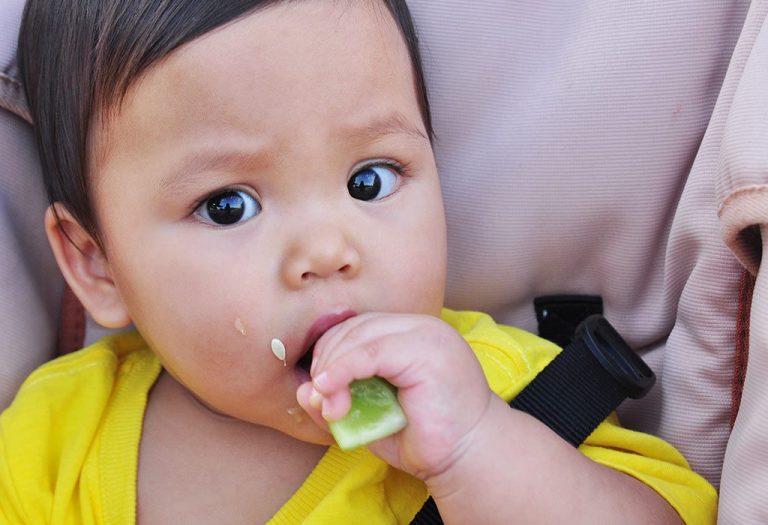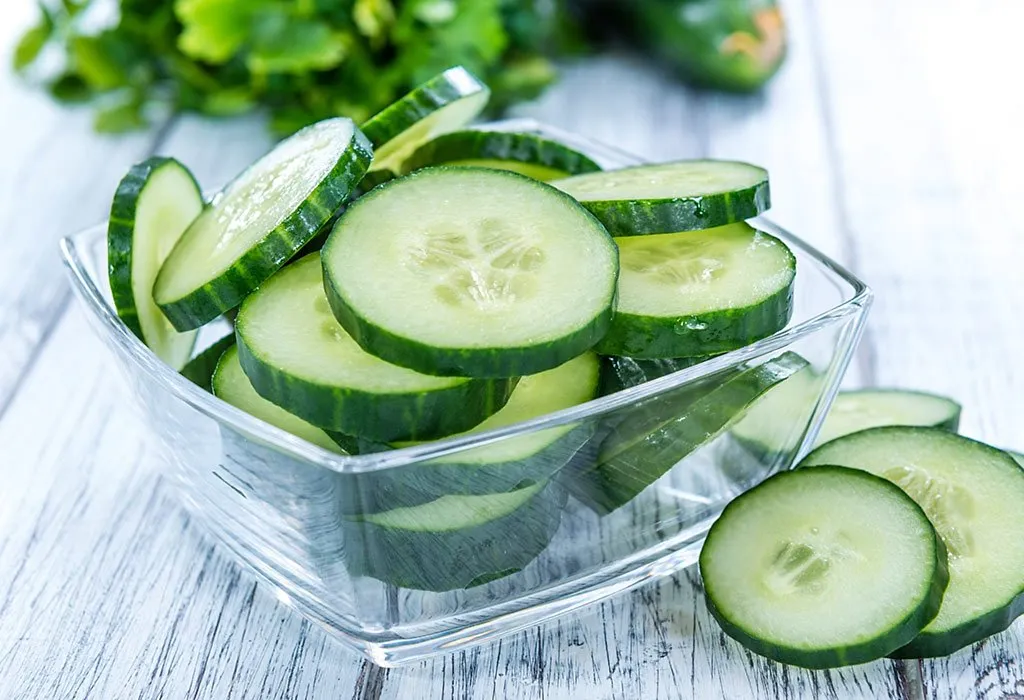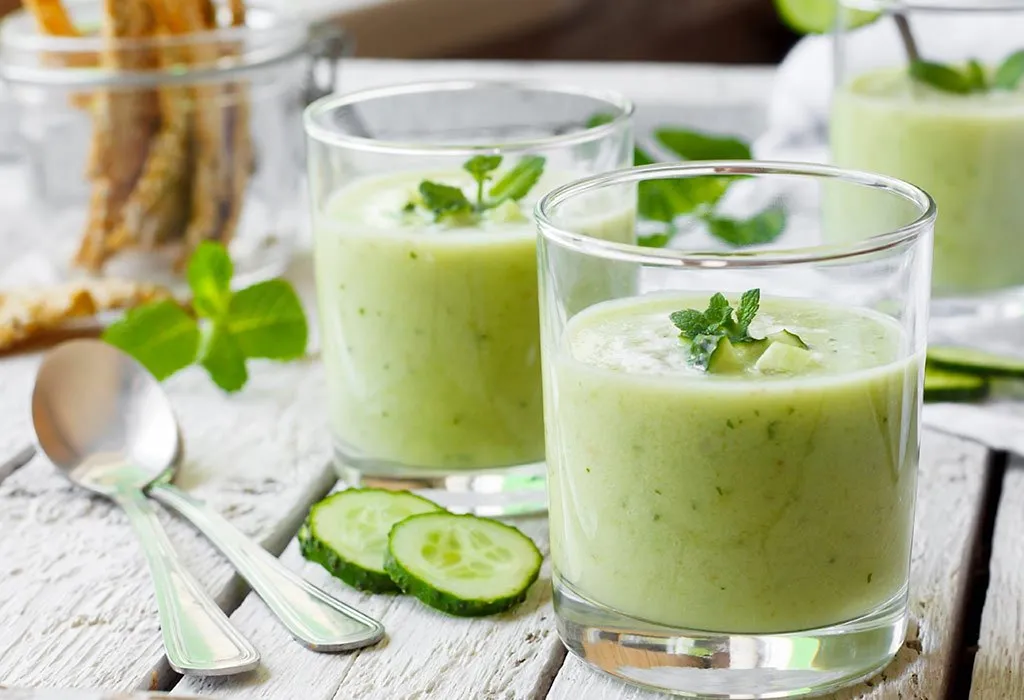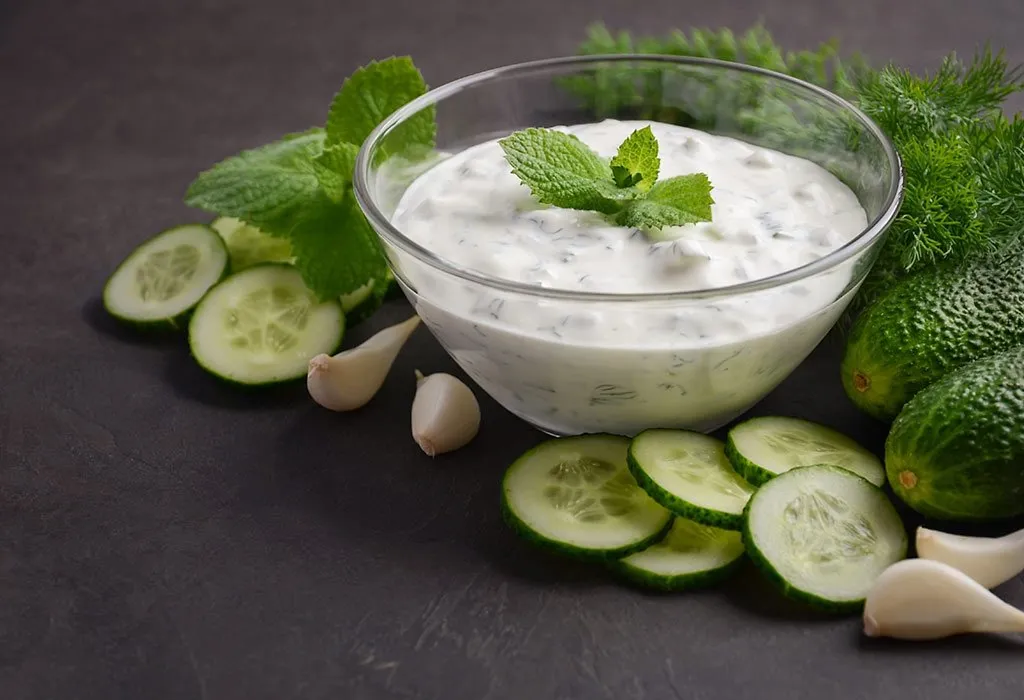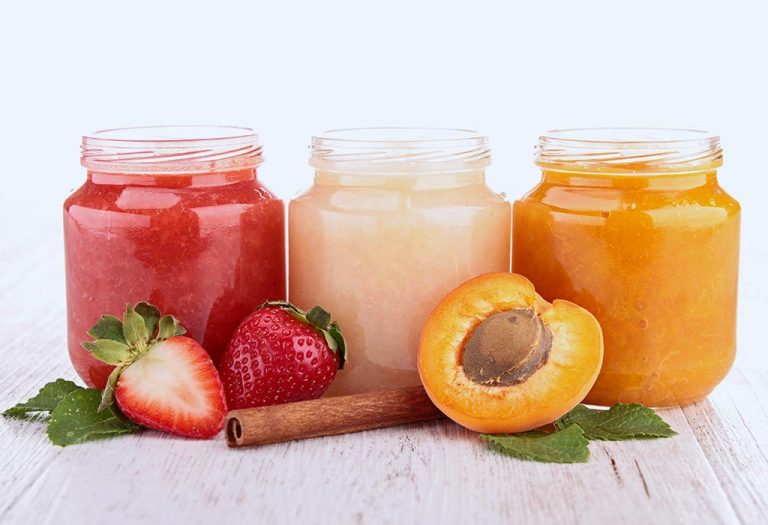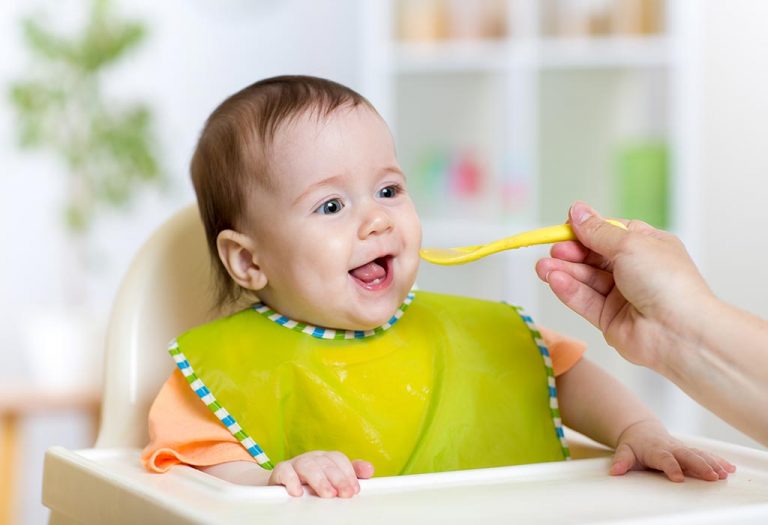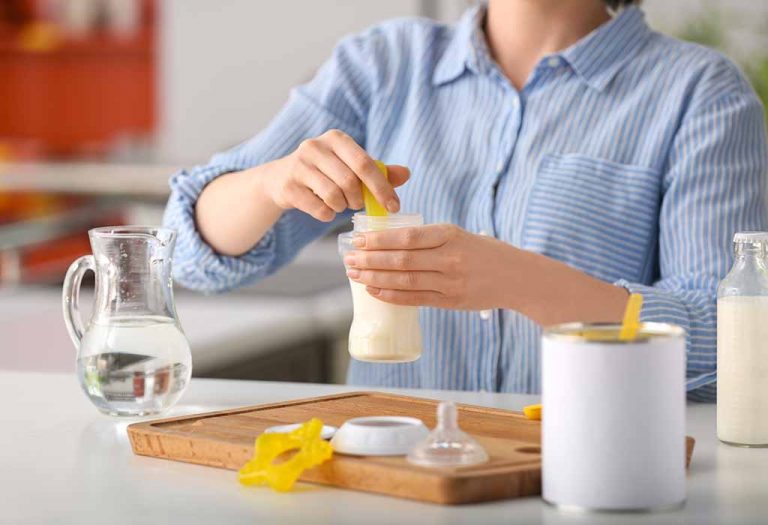Introducing Cucumber to Babies – Benefits, Precautions and Recipes

There is no season, no time, no occasion when cucumber does not form a part of meals in any family. Usually served as a salad or a side dish, cucumbers are even eaten as a random snack or made a vital ingredient in the main course. As your child starts on solids, you might be on the fence with regards to giving him some cucumber to taste since it would be the safest food to try out. But that isn’t the case. Cucumber needs to be fed to a baby the right way and at the right time, keeping a few precautions in mind. So, read on to understand all about cucumber for infants.
Can Babies Have Cucumber?
On a general note, as it comes to other solids and vegetables and fruits that are good for your baby, cucumber can also be considered in the same category. Giving your baby cucumber is not a problem and can help him reap the benefits from its nutrition. But it should be introduced at the right time. Find out when can you include cucumber in your baby’s diet.
When Can You Introduce Cucumber to Your Child?
Babies should be introduced to solids when they turn six months old. However, most doctors recommend continuing breastfeeding until the baby is at least a year old, along with introducing foods. You can introduce cucumber to your baby after six to eight months of age after checking with your baby’s doctor. And when you do that, make sure you remove the seeds when you give it.
Nutritional Value of Cucumber
Contrary to what people might know, there are tons of nutrients present in cucumber that make it an absolutely healthy vegetable item. In a 100g serving of peeled cucumber, the distribution of its nutrition is as follows:
| Nutrient | Quantity |
| Fluoride | 1.3 mcg |
| Water | 95 per cent |
| Zinc | 0.23 mg |
| Sodium | 10.2 mg |
| Potassium | 50 mg |
| Phosphorous | 25 mg |
| Manganese | 0.080 mg |
| Magnesium | 15 mg |
| Iron | 0.60 mg |
| Calcium | 10 mg |
| Vitamin K | 16.5 mcg |
| Vitamin C | 7 mg |
| Folate | 7.1 mcg |
| Vitamin B6 | – |
| Vitamin B5 | 0.26 mg |
| Niacin | 0.2 mg |
| Riboflavin | 0.035 mg |
| Thiamine | 0.03 mg |
| Protein | 0.4 g |
| Fat | 0.1 g |
| Fibre | 0.52 g |
| Sugars | 1.65 g |
| Carbohydrates | 2.5 g |
| Energy | 13 kcal |
Health Benefits of Cucumber for Babies
Eating cucumber can provide your baby with a lot of nutrition as well as advantages that help in keeping your little one healthy throughout his growth.
1. Alleviates Skin Issues
The sensitive skin of your baby can easily react to various attacks on it, ranging from an insect bite to a small burn. These usually end up in leaving a tiny area of an eruption that can get quite irritating. The quality of cucumber to help soothe your skin is well-known among women. Cutting a slice of a cucumber and placing it on the irritated area can provide relief from the pain and lessen the swelling to a certain degree as well (1).
2. Provides Relief From Pain
Taking medicinal painkillers may not always be possible for a baby given its immaturity of growth as of yet. It has been observed that cucumber can also show certain tendencies which are reminiscent of the action shown by such painkillers. This is primarily due to the presence of flavonoids that are present in it. These are known to have analgesic properties that can help in relieving pain in certain situations.
3. Provides Relief From Stomach Problems
Cucumber also provides relief from stomach problems. Be it acidity, ulcers or any kind of gastric problems, the natural remedy to go for is consuming cucumber. Drinking cucumber juice that has been prepared by steaming it, crushing the pieces and squeezing out the pulp is the best way to give a baby. Cucumber water is known to provide similar benefits, too.
4. Good for Hydration
Sometimes, babies refuse to drink water or tend to eat items that do not have good water content. This is more frequent in summers when the appetite takes a hit. Cucumbers prove a saviour in this regard since they contain nearly 95 per cent water in their constitution (2). Giving your little one cucumber to chew on can take care of the thirst as well as replenish the necessary salts and minerals in the body, lost due to dehydration.
5. Offer a Multitude of Vitamins
We bet you will give up before you can even count the number of vitamins present in cucumber. It has nearly everything, everything that is needed to support the growth of the child, right from physical, to neurological, to eyesight development, blood circulation, iron synthesis, bone health, and so on.
6. Boosts Immune System
Cucumbers contain antioxidants, including vitamin C and beta-carotene, which play a crucial role in strengthening the immune system (3). These antioxidants help protect the body against infections and illnesses, keeping your baby healthier and more resilient.
How to Serve Cucumber to Baby?
Introducing cucumber to your baby’s diet can be a refreshing and nutritious addition. It’s important to serve cucumber in an age-appropriate manner to ensure safety and maximize its health benefits. Here’s how you can serve cucumber to your baby at different stages of their development:
For 6 to 8 Months
- Pureed or Mashed: Steam the cucumber until soft and blend it into a smooth puree. You can mix it with other pureed fruits or vegetables for added flavor.
- Cucumber Juice: Extract the juice from fresh cucumbers and offer it in a sippy cup or spoon-fed. Ensure the juice is free from seeds and skin.
For 9 Months+
- Cucumber Sticks: Peel and cut the cucumber into thin sticks that are easy for your baby to hold and chew on. This helps with teething and introduces them to new textures.
- Grated Cucumber: Grate the cucumber and mix it with yogurt or mashed avocado for a nutritious snack or meal addition.
For 12 Months+
- Cucumber Slices: Slice the cucumber into thin, bite-sized pieces. You can serve these as a finger food or add them to salads and sandwiches.
- Cucumber Dip: Create a simple dip by blending cucumber with yogurt and herbs. Serve it with other vegetables or breadsticks for a fun and healthy snack.
For 18 Months+
- Cucumber Salad: Combine cucumber slices with other vegetables, fruits, and a light dressing to make a colorful and nutritious salad.
- Stuffed Cucumber Boats: Hollow out thick cucumber slices and fill them with hummus, cottage cheese, or a mixture of finely chopped vegetables. This makes a fun and interactive snack for your toddler.
Precautions to Take While Giving Cucumber to Your Baby
Before you ask how to make baby food with cucumber for your child, there are certain precautions you need to keep in mind.
- Mix and match the cucumber with other vegetables. You can blend them to make a puree and make it palatable for the little one.
- Check for allergies when you give cucumber the first time. Give a small amount and maintain a gap of a few days to notice any untoward reactions. Follow up if everything is safe.
- Avoid giving raw cucumber since it might contain microbes inside. Always prepare by boiling and steaming it thoroughly to make puree easily and kill any bacteria inside.
- Remove the skin of the cucumber before preparing it for feeding. A baby’s stomach may not be able to digest it right away.
- Purchase cucumbers that are healthy and free of any blemishes. Take a bite to ensure they are not bitter.
- Ensure that cucumber pieces are cut into sizes appropriate for your baby’s age to prevent choking hazards. For younger babies, cucumber should be pureed or mashed, while older babies can handle small, bite-sized pieces.
- Start with a small amount of cucumber and gradually increase the quantity. This allows you to monitor your baby’s reaction and digestive tolerance to the new food.
- Always wash cucumbers thoroughly under running water to remove any pesticides or dirt. Consider using a vegetable wash for extra safety.
- Do not add salt, sugar, or other seasonings to cucumber when preparing it for your baby. Babies’ kidneys are not fully developed, and excessive salt or sugar can be harmful.
- Keep an eye on your baby’s digestive response after introducing cucumber. Some babies might experience gas or discomfort, in which case, it might be best to delay reintroducing cucumber until their digestive system matures further.
Cucumber Baby Food Recipes
Here are a few easy-to-make cucumber recipes that you can give to your baby.
1. Cucumber Puree
Here’s a recipe for cucumber puree for a baby with the benefit of other veggies.
What You Will Need
- Cucumber – 1/2
- Basil leaves – 2-3
- Sour cream – 1 cup
- Cheese salt or non-iodized salt – 1/2 tsp
How to Make
- Peel and cut the cucumber in strips and remove the seeds. Mash together and with all other ingredients until the consistency is good. Add salt and serve!
2. Minty Cucumber With Curd
A nice recipe complemented with the right fruit for some added flavour.
What You Will Need
- Cucumber – 1/2
- Mint leaves – 2-3
- Curd – 1 cup
- Pear – 1/2
How to Make
- Peel and cut the cucumber and remove the seeds. Chop it then squish it down.
- Peel the pear, remove the core, and dice. Take one half and squish it.
- Add mint leaves and curd in a bowl and mix it well.
- Blend it further to make a puree if needed.
3. Cucumber and Avocado Mash
This creamy and nutritious recipe combines cucumber with avocado for a smooth and tasty baby meal.
What You Will Need
- Cucumber – 1/2
- Ripe Avocado – 1/2
How to Make
- Peel and cut the cucumber into small pieces, removing the seeds.
- Scoop out the avocado flesh and cut it into small pieces.
- Mash the cucumber and avocado together until smooth. You can also blend it for a finer consistency.
- Serve immediately to your baby.
How to Prepare Cucumber for Baby-led Weaning?
Here’s a guide on how to serve cucumbers in BLW effectively at different stages of your baby’s development to support their self-feeding journey.
1. Large Unpeeled Spears (6-8 Months)
Serving large, unpeeled cucumber spears can be a practical option for very young babies who are just beginning to explore solid foods. If you’re uncomfortable with this method, you might choose another approach. The elongated shape of the cucumber spears makes them easy for little hands to hold, and the skin helps keep the cucumber intact, reducing the risk of breaking off small pieces. Although babies might not actually eat much, these cold spears can soothe sore gums, and they might manage to get some watery seeds off the spears. To prepare, cut the cucumber lengthwise into quarters, then cut a quarter into long spears roughly the length of your finger. Once your baby has teeth or can bite pieces off, it’s safer to discontinue this method to prevent choking risks.
If a piece accidentally comes off and your baby starts to choke, do not put your fingers in their mouth, as this could push the piece further down. Instead, gently guide your baby to lean forward, open their mouth, and stick out their tongue. You can also support them by placing your hand under their chin to encourage them to spit out the piece.
2. Grated Cucumber (6+ Months)
Grated cucumber is a suitable option for babies as young as six months, though they may not consume large quantities. Simply place a small amount of grated cucumber on their tray or plate, allowing them to explore and scoop it into their mouth. Grated cucumber can also be mixed into other foods, such as tzatziki, to enhance flavor and add nutrition.
3. Peeled, Paper-Thin Strips (9+ Months)
As your baby grows and develops better chewing skills, you can start offering peeled cucumber cut into very thin strips. This approach is ideal for older babies who can handle more complex textures. After the age of twelve months, you can use the same method to cut the cucumber into half-circle shapes for variety.
FAQs
1. Can cucumbers cause allergic reactions in babies?
Although rare, some babies might have an allergic reaction to cucumbers. It’s important to introduce cucumbers gradually and watch for any signs of allergy, such as rash, swelling, or gastrointestinal upset.
2. Is it safe to give pickled cucumbers to babies?
Pickled cucumbers are not recommended for babies due to their high salt content and potential preservatives. It’s best to stick with fresh cucumbers to avoid any adverse effects on your baby’s health.
3. How can I prevent digestive issues when introducing cucumbers?
To minimize the risk of digestive discomfort, start with small amounts of cucumber and ensure it is prepared appropriately (e.g., peeled and cut into manageable pieces). Monitor your baby’s response and consult a pediatrician if any digestive issues arise.
4. Can cucumbers affect my baby’s iron absorption?
Cucumbers are low in iron but high in vitamin C, which can aid in the absorption of iron from other foods. Pair cucumbers with iron-rich foods like spinach or lentils to support your baby’s iron intake.
Cucumber is very tasty and can be introduced to little ones but if you are planning to add it your baby’s diet, do check with a paediatrician before doing so. If you get a go-ahead from your doctor, keep a lookout for allergic reaction and prepare baby food with cucumber in a healthy way for your little one to enjoy.
References/Resources:
1. Mukherjee. P, Nema. N, Maiti. N, Sarkar. B; Phytochemical and therapeutic potential of cucumber (Fitoterapia); National Library of Medicine; https://pubmed.ncbi.nlm.nih.gov/23098877/; January 2013
2. Cucumber, raw; Food Data Central; U.S. Department of Agriculture; https://fdc.nal.usda.gov/fdc-app.html#/food-details/1103352/nutrients
3. Kumar. D, Kumar. S, Singh. J, Narender, Rashmi, et. al.; Free Radical Scavenging and Analgesic Activities of Cucumis sativus L. Fruit Extract (Journal of Young Pharmacists); National Library of Medicine; https://www.ncbi.nlm.nih.gov/pmc/articles/PMC3019374/
4. Kaushik. U, Aeri. V, Mir. S; Cucurbitacins – An insight into medicinal leads from nature (Pharmacognosy Reviews); National Library of Medicine; https://www.ncbi.nlm.nih.gov/pmc/articles/PMC4441156/
5. Cucumber; Colorado State University; https://www.chhs.colostate.edu/fsi/food-articles/produce-2/cucumbers/
6. Guelinckx. I, Tavoularis. G, König. J, et. al.; Contribution of Water from Food and Fluids to Total Water Intake: Analysis of a French and UK Population Surveys (Nutrients); National Library of Medicine; https://www.ncbi.nlm.nih.gov/pmc/articles/PMC5084017/; October 2016
7. Heidari. H, Kamalinejad. M, Noubarani. M, Rahmati. M, et. al.; Protective mechanisms of Cucumis sativus in diabetes-related modelsof oxidative stress and carbonyl stress (Bioimpacts); National Library of Medicine; https://www.ncbi.nlm.nih.gov/pmc/articles/PMC4916550/; March 2016
Also Read:
Spinach for Infants – Health Benefits & Recipes
Health Benefits of Tomatoes for Babies
When & How to Introduce Carrot to Babies?
Cauliflower for Babies – When & How to Give?
Was This Article Helpful?
Parenting is a huge responsibility, for you as a caregiver, but also for us as a parenting content platform. We understand that and take our responsibility of creating credible content seriously. FirstCry Parenting articles are written and published only after extensive research using factually sound references to deliver quality content that is accurate, validated by experts, and completely reliable. To understand how we go about creating content that is credible, read our editorial policy here.






